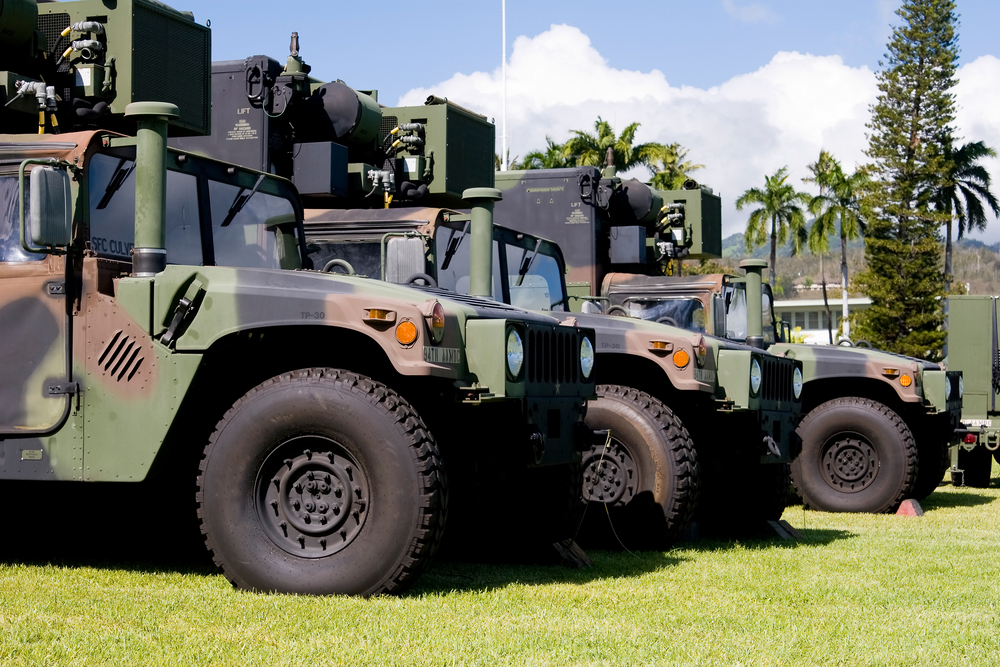Chemical agent resistant coatings (CARCs) are a specialized paint system explicitly designed to protect against chemical agents and other hazardous materials. It gained widespread use beginning in the 1980s, and because it requires solvents and specialized processes to apply to equipment. However, companies should only apply this valuable tool on specific substrates.
Today, we’ll discuss the benefits and challenges of CARCs on military equipment.
Understanding the Importance of Chemical Agent Resistant Coatings (CARC)
CARCs are specifically designed to protect surfaces from chemical agents. It is used extensively on military vehicles, equipment, and weapons. CARCs are a two-component coating system that consists of a primer and a topcoat. The primer acts as a bonding agent to ensure adhesion, while the topcoat provides chemical resistance.
The overall goal of CARCs is to prevent chemical warfare agents from soaking into military equipment. Rather, these agents bead up, just like water on a newly waxed car, allowing for easier decontamination procedures when a chemical agent is detected. Modern CARCs can go one step further and actually change color in the presence of chemical agents.
Benefits of Chemical Agent Resistant Coatings (CARC)
Chemical agent resistant coatings are also more robust than ordinary coatings, and they last up to four times longer than standard alkyd paints. This durability means your equipment will last longer, in addition to giving you an edge during decontamination. CARC paints also withstand harsh conditions and environments, like extreme heat and cold, or when petroleum comes in contact with the equipment.
In ordinary conditions, CARCs can make equipment last longer, making them more cost-effective and durable while lengthening their effective lifespans. You’ll also have reduced maintenance costs.
The pigments used in CARCs can ablate heat in some instances. The base green color, Green 383, uses pigments that mimic the reflective properties of chlorophyll. Rather than reflecting more heat, these paints absorbed some of the heat, making them harder to detect with IR systems. The color Tan 686 underwent a reformulation for the Gulf War to reduce the amount of solar heat the paint absorbed. This measure prevented overheating while trying to keep soldiers cooler in the desert environment.
How CARCs Are Applied
There is a three-step process for applying chemical agent resistant coatings, and it requires special handling as volatile organic compounds (VOCs) are involved.
First, the base substrate must be thoroughly cleaned, making it more amenable to receiving the CARC paint and topcoat. This process might include a bath in zinc phosphate, depending on the substrate.
Next is a primer that adds a protective layer to the substrate. The primer can be water- or epoxy-based, depending on your requirements.
Finally, there is the topcoat. This is where the pigment is applied, and an epoxy resin seals the entire surface in a protective layer. Because these are polyurethanes, special care must be taken to apply CARCs on any surface. Just like ordinary epoxies, the pigment is made by mixing one container with another before applying it. Then, the equipment must cure completely before it is ready for service.
Challenges Associated With CARCs
Chemical agent resistant coatings are not easily applied. If they start to wear off of equipment due to nicks or dings or overall age, special maintenance bays should handle the application. CARCs should be applied in a well-ventilated area with hoods to gather and expel the vapors to the outside.
All units should be aware of the safety concerns revolving around CARC.
1. Conduct Regular Inspections
Regular inspections of military equipment coated with chemical agent resistant coatings can help identify any signs of damage or wear early on. This step allows for timely repairs or replacement, ensuring that the coating remains effective in protecting against chemical warfare agents. If a CARC needs repairs, send it in for maintenance. Soldiers should not brush CARC on without proper PPE.
2. Follow Proper Application Procedures
You must follow the correct application procedures for CARCs. Otherwise, it won’t be as effective. Even when affecting repairs, CARCs must be applied correctly. Safety protocols must be followed, which is why a professional company or specially trained unit should handle this aspect of CARC maintenance.
3. Partner With a Reputable Industrial Coating Company
Be sure to partner with a reputable industrial coating company that specializes in providing high-quality chemical agent resistant coatings. The company will apply the coatings properly and professionally. The experts at Coating Systems are MIL-SPEC compliant.
Contact Coating Systems for a consultation. We can determine how to coat your industrial equipment for maximum performance and effectiveness.


